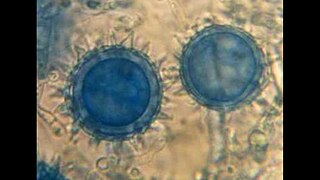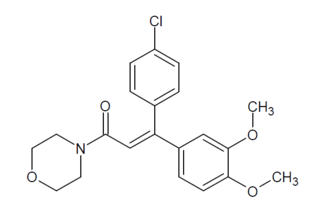
The Oomycetes, or Oomycota, form a distinct phylogenetic lineage of fungus-like eukaryotic microorganisms within the Stramenopiles. They are filamentous and heterotrophic, and can reproduce both sexually and asexually. Sexual reproduction of an oospore is the result of contact between hyphae of male antheridia and female oogonia; these spores can overwinter and are known as resting spores. Asexual reproduction involves the formation of chlamydospores and sporangia, producing motile zoospores. Oomycetes occupy both saprophytic and pathogenic lifestyles, and include some of the most notorious pathogens of plants, causing devastating diseases such as late blight of potato and sudden oak death. One oomycete, the mycoparasite Pythium oligandrum, is used for biocontrol, attacking plant pathogenic fungi. The oomycetes are also often referred to as water molds, although the water-preferring nature which led to that name is not true of most species, which are terrestrial pathogens.

Phytophthora is a genus of plant-damaging oomycetes, whose member species are capable of causing enormous economic losses on crops worldwide, as well as environmental damage in natural ecosystems. The cell wall of Phytophthora is made up of cellulose. The genus was first described by Heinrich Anton de Bary in 1875. Approximately 210 species have been described, although 100–500 undiscovered Phytophthora species are estimated to exist.

Gerbera jamesonii is a species of flowering plant in the genus Gerbera belonging to the basal Mutisieae tribe within the large Asteraceae family. It is indigenous to South Eastern Africa and commonly known as the Barberton daisy, the Transvaal daisy, and as Barbertonse madeliefie or Rooigousblom in Afrikaans. It was the first species of Gerbera to be the subject of a scientific description, studied by J. D. Hooker in Curtis's Botanical Magazine in 1889.

Pythium oligandrum is an oomycete. It is a parasite of many fungi and other oomycetes including Botrytis, Fusarium and Phytophthora. It has been licensed as a biocontrol agent in the form of an oospore soil treatment, which reduces pathogen load and concomitant plant disease. P. oligandrum have been found to express several genes belonging to the CAZy-family when feeding on prey. P. oligandrum can grow within the roots of certain plants, including tomato and sugar beet. Production of auxin-like substances stimulate plant growth. Defense responses can be induced in the plant, which primes the plant from further infection by pathogenic fungi, oomycetes or bacteria.

Pythium is a genus of parasitic oomycetes. They were formerly classified as fungi. Most species are plant parasites, but Pythium insidiosum is an important pathogen of animals, causing pythiosis. The feet of the fungus gnat are frequently a vector for their transmission.

Metalaxyl is an acylalanine fungicide with systemic function. Its chemical name is methyl N-(methoxyacetyl)-N-(2,6-xylyl)-DL-alaninate. It can be used to control Pythium in a number of vegetable crops, and Phytophthora in peas. Metalaxyl-M is the ISO common name and Ridomil Gold is the trade name for the optically pure (-) / D / R active stereoisomer, which is also known as mefenoxam.
Root rot is a condition in which anoxic conditions in the soil or potting media around the roots of a plant cause them to rot. This occurs due to excessive standing water around the roots. It is found in both indoor and outdoor plants, although it is more common in indoor plants due to overwatering, heavy potting media, or containers with poor drainage. The leaves of plants experiencing root rot often yellow and die, and if allowed to continue, the condition can be fatal.

Damping off is a horticultural disease or condition, caused by several different pathogens that kill or weaken seeds or seedlings before or after they germinate. It is most prevalent in wet and cool conditions.
Pythium ultimum is a plant pathogen. It causes damping off and root rot diseases of hundreds of diverse plant hosts including corn, soybean, potato, wheat, fir, and many ornamental species. P. ultimum belongs to the peronosporalean lineage of oomycetes, along with other important plant pathogens such as Phytophthora spp. and many genera of downy mildews. P. ultimum is a frequent inhabitant of fields, freshwater ponds, and decomposing vegetation in most areas of the world. Contributing to the widespread distribution and persistence of P. ultimum is its ability to grow saprotrophically in soil and plant residue. This trait is also exhibited by most Pythium spp. but not by the related Phytophthora spp., which can only colonize living plant hosts.

Phytophthora erythroseptica—also known as pink rot along with several other species of Phytophthora—is a plant pathogen. It infects potatoes causing their tubers to turn pink and damages leaves. It also infects tulips (Tulipa) damaging their leaves and shoots.
The laimosphere is the microbiologically enriched zone of soil that surrounds below-ground portions of plant stems; the laimosphere is analogous to the rhizosphere and spermosphere. The combining form laim- from laimos denotes a connecting organ (neck) while -sphere indicates a zone of influence. Topographically, the laimosphere includes the soil around any portion of subterranean plant organs other than roots where exuded nutrients stimulate microbial activities. Subterranean plant organs with a laimosphere include hypocotyls, epicotyls, stems, stolons, corms, bulbs, and leaves. Propagules of soil-borne plant pathogens, whose germination is stimulated by a plant exudates in the laimosphere, can initiate hypocotyl and stem rots leading to "damping-off". Pathogens commonly found to cause such diseases are species of Fusarium, Phoma, Phytophthora, Pythium, Rhizoctonia and Sclerotinia.
Pythium oopapillum is a plant pathogen, first isolated in Canada.
Globisporangium sylvaticum is a plant pathogen, an oomycete known to cause root rot and damping off in a multitude of species. These species include apples, carrot, cherry laurel, cress, cucumber, garlic, lettuce, pea, rhododendron, and spinach. Symptoms of infection include stunting, wilt, chlorosis, and browning and eventual necrosis of roots. The pathogen can by identified by the presence of thick, microscopic, round spores within the cells of the root.

Dimethomorph is a fungicide with systemic function. It is used for treating mildew and root rot caused by organisms such as Pythium and Phytophthora species.

Grace Marion Waterhouse (1906-1996) was a British mycologist who worked for the International Mycological Institute in Kew for 20 years. She was an expert on the identification and taxonomy of Phytophthora plant pathogens. She gathered a large collection of Phytophthora cultures, and published two seminal works on the genus: a key to the species and a compilation of species descriptions.
Black rot on orchids is caused by Pythium and Phytophthora species. Black rot targets a variety of orchids but Cattleya orchids are especially susceptible. Pythium ultimum and Phytophthora cactorum are known to cause black rot in orchids.
A soil borne pathogen is a disease-causing agent which lives both in soil and in a plant host, and which will tend to infect undiseased plants which are grown in that soil. Common soil borne pathogens include Fusarium, Pythium, Rhizoctonia, Phytophthora, Verticillium, Rhizopus, Thielaviopsis, and nematodes including Meloidogyne.
INF1s are elicitins, proteins which are produced by plant pathogens and recognized by hosts. They are produced by Phytophthora, Pythium, and Pseudomonas spp.









